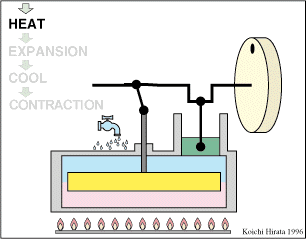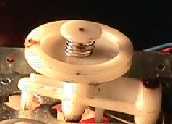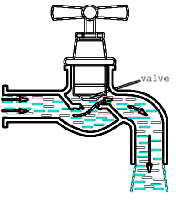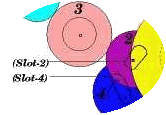"How Things Work" Project Reports
Instructors: Amitabha Mukerjee and M.K. Muju
ME 371 Hands-On Lab, July-November 1999
In this project student teams opened, broke, destroyed, and otherwise explored various devices, most of which (toys, clocks, taps, locks, switches, telephone) are commonly found around the house.


List of Projects
-
Somersaulting Dog Toy
Dilip Sah, Alok Tiwari, Amit KumarThis adorable dog barks and walks. Then it stops, crouches on its rear legs and springs up to perform a somersault and land on its feet. Its plush body hides a clever mechanism that activates different geartrains by shifting a gear shaft through a face cam, causing a spring to wind up. The edge of the same cam controls the timing for releasing the spring, making the rear legs kick out: Voila - Somersault!
- Dial Telephone
Anand Prakash, Anshul Pradhan, Bhavik GuptaAfter releasing the dialler in a dial telephone, why does it return at a slow, controlled speed? Because it has this governor which controls the return speed - at a limiting r.p.m., the two brake halves bulge out against the spring to brake the motion. The dialling mechanism is a wonder of electromechanical design. A cam oscillates two leaf springs while a plugger prevents one from moving, thus breaking an electrical contact repeatedly (by the number dialled). Relays in the exchange then move up by the appropriate numbers, making the connection.
- Stirling Engine
Abhishek Singh, Abhijit Tiwary, Avinash KumarThis group studied a Stirling Engine that was constructed last year at IIT Kanpur by Prof. P.K. Das. Air heated at the bottom expands and pushes the piston up which causes the displacer (yellow) to move down. This displaces the air upwards, `where it is cooled, causing the piston to come down. This image is from the page by Koiichi Hirata which contains the most lucid explanations of how the Stirling Engine works. Discover the enormous potential of this highly efficient and invertible engine and how it is poised to change our lives in the near future.
- Tape Deck
Mechanism
Adarsh Garg, Mitul Saha, Manish K MisraThe tape-deck employs several sliding plates carrying pulleys and idlers that couple with two belt-driven pulleys to provide all the functionality of a tape-transport mechanism. Here is the clutch (pushed down by the spring) which runs at fast-forward speed but can slip when the tape is slowed down to a constant speed by the capstan.
-
Air Gun
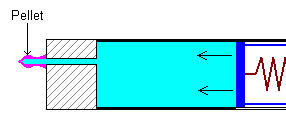 Animesh Kumar, Brijesh Tripathi, Ayon Dutta
Animesh Kumar, Brijesh Tripathi, Ayon Dutta
When you cock the barrel to insert the pellet in an air gun,
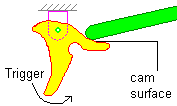 the piston is moved back
and a spring is energized. A lever connected to the trigger holds
the spring back. Upon releasing the trigger, the piston compresses
the air in the cavity which propels the pellet.
Let the
wonderful illustrations by this
group guide you through
the intricacies of an air gun.
the piston is moved back
and a spring is energized. A lever connected to the trigger holds
the spring back. Upon releasing the trigger, the piston compresses
the air in the cavity which propels the pellet.
Let the
wonderful illustrations by this
group guide you through
the intricacies of an air gun.
- Pendulum
Clock
Mudit Khandelwal, Deepak Jha, and Kamal Gupta The pendulum is one of the oldest clockwork principles. This antique
clock (circa 1910)
is the product of a long process of mechanical innovation. An
interesting aspect is the use of needle gears (visible here) for
transferring motion between sprockets.
QUIZ: What causes the gong to sound every half-hour and hour? Find out
about the escapement and how it controls the unwinding of the
spring.
The pendulum is one of the oldest clockwork principles. This antique
clock (circa 1910)
is the product of a long process of mechanical innovation. An
interesting aspect is the use of needle gears (visible here) for
transferring motion between sprockets.
QUIZ: What causes the gong to sound every half-hour and hour? Find out
about the escapement and how it controls the unwinding of the
spring.
ANSWER: A notched wheel with deeper notches for every gong and shallower notches in-between where the gong ends. This runs in sync with the hour hand. -
Hard Disk Drive
Naveen Tiwari, Amit Singh, Subhash Bauddha, Rakesh Kumar The parallel arms scurry in and out positioning multiple heads
along the face of the plattens.
The gap between the head and platten is in microns to minimize
magnetic flux loss. Meanwhile the disk is spinning at dizzying speeds
to maximize data transfer rates, inducing
a vacuum under the head (due to the high velocity
air flowing through this gap). All this motion incuces some vibration,
and if you have ever had a hard disk
crash, it was probably because the head lightly scraped the
surface. That this happens surprisingly infrequently is the marvel of
this mechatronics design that is right now providing the data for this
very display that you are reading!
The parallel arms scurry in and out positioning multiple heads
along the face of the plattens.
The gap between the head and platten is in microns to minimize
magnetic flux loss. Meanwhile the disk is spinning at dizzying speeds
to maximize data transfer rates, inducing
a vacuum under the head (due to the high velocity
air flowing through this gap). All this motion incuces some vibration,
and if you have ever had a hard disk
crash, it was probably because the head lightly scraped the
surface. That this happens surprisingly infrequently is the marvel of
this mechatronics design that is right now providing the data for this
very display that you are reading!
- Water Tap
Jagmeet Singh, Gautam Sethi, Gaurav AhujaWater taps come in many shapes and sizes. Plastic taps are cheap. Brass is expensive. How do they differ? Why brass? What is a stopcock tap? Explore the many designs of this everyday household item.
-
Tumbling Monkey
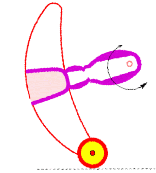 Mohit Kumar, Duttatrey Parashar, Ashish Mohan
Mohit Kumar, Duttatrey Parashar, Ashish MohanToys are an expression of unbridled creativity -
 there is so much we can learn from them. This monkey loops down
with both arms while its tail is swiveling. It caterwauls and
tumbles with prodigious energy to create a hilarious effect.
Yet all that it has is two shafts turning at constant speed! The
banana it holds is really a cam which lifts the body.
There is a wheel at the tip to
aid the instability when the tail topples it from the back.
there is so much we can learn from them. This monkey loops down
with both arms while its tail is swiveling. It caterwauls and
tumbles with prodigious energy to create a hilarious effect.
Yet all that it has is two shafts turning at constant speed! The
banana it holds is really a cam which lifts the body.
There is a wheel at the tip to
aid the instability when the tail topples it from the back. - Pull-back Car
Vineet Khare, Shikhar Maini, Shahnawaz FaiyazWhen this toy car is pulled back a few inches, it travels right across the room. The energy must be stored quickly but released slowly. This is achieved using two different gear trains in the same tiny gearbox - when pulled back, the spring tightens fifteen times faster than when it unwinds. The innovation lies in two floating gears - the axes of gears 2 and 4 move along two slots in the gearcage depending on the tangential forces acting on them. Explore the details of this ingenuous mechanism.

